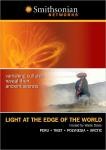| Reviews & Columns |
|
Reviews DVD TV on DVD Blu-ray 4K UHD International DVDs In Theaters Reviews by Studio Video Games Features Collector Series DVDs Easter Egg Database Interviews DVD Talk Radio Feature Articles Columns Anime Talk DVD Savant Horror DVDs The M.O.D. Squad Art House HD Talk Silent DVD
|
DVD Talk Forum |
|
|
| Resources |
|
DVD Price Search Customer Service #'s RCE Info Links |
|
Columns
|
|
|
Light at the Edge of the World
WADE DAVIS: You know the year that I was born, there were 6000 languages spoken on Earth...Language is a reflection of culture; it's a flash of the human spirit....and of the 6000 language, only half are taught to children.
Dr. Wade Davis is only 55 years old and the point he makes during the opening of "Light at the Edge of the World," is chilling. In a matter of years, half the spoken languages on Earth could be lost forever, and with those languages a wide variety of culture. "Light at the Edge of the World" is a four-part documentary series that examines four very different geographic locations and its inhabitants, who are at risk of fading into the history books. Hosted by Wade Davis (the man who decades prior researched the possible existence in Haiti that was turned into the semi-biographical, but highly fictionalizes horror film, "The Serpent and the Rainbow"), the viewer is treated to the beauty of these landscapes as well as the beauty of the cultures and people who call these places home.
The biggest asset "Light at the Edge of he World" has going for it, is Wade Davis. He is a likable narrator/host, and never talks above the audience. He speaks in a matter-of-fact fashion and his interest in the subject matter is genuine. I found all four, 45-minute episodes fascinating and informative. The locales are very unique ranging from the freezing climate of the Arctic to the serene beauty of oceanic Polynesia. Most importantly, the show, offers a glimpse into the lives of these cultures and raises the awareness of the impact their losses will have on humanity.
Each episode of the series is set up like a cross between a standard documentary and travel show. Davis integrates himself into the cultures he studies and brings the viewer along for the trip. There is no sensationalism in the series; the purpose is clear and simple: see how these people live their normal lives. The cultures appear to have been carefully chosen to represent a wide variety of daily life. In the Arctic, Davis travels with the Inuit, a society who hunts to survive. In Peru, the people are farmers, and in Polynesia, fishing is a huge part of life. Davis brings us along for a trip on a fishing boat as we learn, how despite using more modern vessels, the people still rely on amazing sea navigation skills passed down for generations.
The last culture Davis spends time with, Buddhist monks in Tibet is the most different of all the episodes. Davis spends time with the monks learning about their highly spiritual lives. Of all the episodes however, this may be the most clichéd, as Tibetan monks are arguably a more well known culture, especially following the 'Free Tibet' movement that gained a large Hollywood following. While the threat to this culture is well known, Davis includes short pieces on the threat these cultures face, ranging from suicide to the slow fading of tradition.
"Light at the Edge of the World" is a very satisfying set of programs and one I had never heard of until now. Anyone interested in other cultures or the world in general should give his a look. It's very accessible for all audiences and worth watching more than once if you find the people or topics fascinating as I did.
THE DVD
The Video
"Light at the Edge of the World" is presented with a Non-Anamorphic 1.85:1 Widescreen transfer. This is very disappointing, especially since each episode begins with a Smithsonian HD logo; this transfer is far from even near HD quality. It has a soft look, but despite capturing the colors of the different locations adequately, suffers from some fairly noticeable edge enhancement. This definitely detracts from the beautiful scenery and is especially disheartening on a 2009 DVD release.
The Audio
The English Dolby 5.1 audio isn't as impressive as one might expect. The dialogue heavy show is a front-end affair, with the full range of audio only picking up for the globally diverse score. Even then, the audio isn't as rich as one would expect it to be. An English 2.0 track is also present as are English subtitles for the hearing impaired.
The Extras
None except for a short commercial for other Smithsonian Channel programs, accessible from the main menu.
Final Thoughts
Simply put, "Light at the Edge of the World" is a fascinating look distant places and people. Wade Davis is an excellent host, and despite the less than top-notch transfer and audio, I still feel confident in the content quality of the disc to say it's worth your time. Recommended.
|
| Popular Reviews |
| Sponsored Links |
|
|
| Sponsored Links |
|
|
| Release List | Reviews | Shop | Newsletter | Forum | DVD Giveaways | Blu-Ray | Advertise |
|
Copyright 2024 DVDTalk.com All Rights Reserved. Legal Info, Privacy Policy, Terms of Use,
Manage Preferences,
Your Privacy Choices | |||||||















